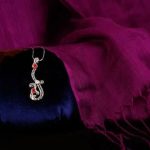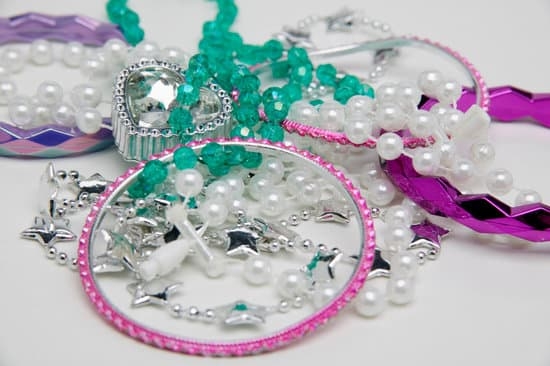Art Deco Egyptian Revival jewelry is an exquisite style of antique jewelry that has become highly popular, largely as a result of both the dramatically ornate pieces and the period in which they were first developed. Originating from ancient Egypt and featuring iconography, motifs and symbols from that era, these pieces have been crafted since the early twentieth century in order to emulate that iconic style.
From bold and intricate band rings to elaborate Egyptian headgear earrings with bejeweled appendages, this unique form of jewelry reveals a rich ancient history that transcends time in its vast array of designs.
Materials Used for Art Deco Egyptian Revival Jewelry Since its inception, Art Deco Egyptian Revival jewelry has been made from various types of metals such as gold, silver and platinum. However, it was particularly favored for its use of gemstones such as lapis lazuli, tiger’s eye, carnelian and quartz to create vibrant colors and contrast within each item.
Intricate metalwork embellishments including filigree details were also added to many pieces to add extra dimension while enhancing their lush aesthetic appeal.
Significance of Art Deco Egyptian Revival Jewelry For centuries now art deco egyptian revival jewelry has held a deep significance in terms of artistry, craftsmanship, culture and wealth. Not only do these pieces make gorgeous additions to any outfit, but they are framed by a long-standing heritage which grants them an extra layer of beauty & charm.
Furthermore, this conceptual treasure trove can be found in both high-end boutiques & more affordable stores alike due to its increasing popularity & availability. While good quality antiques will always retain higher monetary value due to timelessness authenticity & rarity, modern recreations offer buyers stunning choices that suit a variety of pockets & preferences.
Exploring Influence of Ancient Egypt on the Art Deco Style
Egyptian-Revival jewelry became extremely popular during the Art Deco period, often incorporating classic motifs from Ancient Egypt. This movement of fashion embraced a combination of new designs, materials and techniques with the objective of creating bolder statement items.
The Pharaohs and their culture had fascinated Europe shortly after Napoleon’s military campaigns in Egypt, leading to an explosion in the popularity of Egyptian revival styles by the late 1800s. By the 1930s, interest was reignited with Hollywood’s glamorous silent movies depicting ancient cultures such as Cleopatra and Lawrence of Arabia.
This influence on fashion was expressed in a multitude of forms such as dressing gowns, shoes, furniture and especially jewelry. The hallmark features of these pieces were sun gods or symbols such as scarab beetles, camels and cobras. Others showed softer floral or opulent details surrounded by hieroglyphics or Ptolemaic figures.
- Features: Hieroglyphics, animal shapes such as scarab beetles, sun gods or symbols
- Materials Used: Art Deco jewelry commonly used materials including gold, silver and bronze with diamonds and semi-precious stones
- Design Elements: Motifs included bold geometric shapes in a stepped pyramidal form often highlighted with bright enamel colours
Definition of Art Deco and Egyptian Revival Jewelry
Art Deco and Egyptian Revival jewelry are two of the most distinctive jewelry styles of the 20th century. Art Deco is a movement that emerged in France in the mid-1920s and was characterized by modernity, geometrical shapes, and bold colors. It draws its inspiration from both cubism and machine-age workmanship.
On the other hand, the Egyptian Revival movement arose in Europe throughout the 18th century as part of an interest in ancient Egyptian culture. This style of jewelry featured hieroglyphs, scarabs, lotus flowers, pharaoh’s faces, eye of Horus motifs and various ancient gods such as Isis and Nephythys.
The combination of these styles creates a unique opportunity to explore two powerful decorative movements at once. Art Deco was all about sleek lines and smooth surfaces while Egyptian Revival used intricate details such as filigree metalwork to convey its message.
Both Art Deco and Egypt Revival jewelry feature ornamental designs with geometric patterns along with stones embedded in gold or silver settings. The contrast between the two styles give any piece of the jewelry a sense of luxury and sophistication.
Unique to many Art Deco Egyptian Revival jewels are pieces set with rose quartz carved into beetles or birds or amethysts cut into scarab shape that references the symbolism commonly found in Ancient Egypt culture.
During this time period, many jewelers embraced innovations like semi-precious stones for example instead of using rare diamonds exclusively they would pair sapphires or rubies with manufactured stones like glass onyx made by innovative processes such as foiling or cabochon cutting to make them stand out among traditional designs.
Overall, we can see the influence that both Art Deco and Egypt Revival have had on modern day jewelry design trends; from its minimalist shapes to signature details like symbolic hieroglyphics. Jewelry fans today can easily find something truly unique within this era’s diverse design options which come together harmoniously combing both modern contemporary elements with ancient symbolism making it one timeless combination that stays attractive through time no matter what other fashion trends come along.
History of Art Deco and Egyptian Revival Jewelry
Art Deco and Egyptian Revival Jewelry is a type of jewelry that dates back to the 1920s. As its name implies, these styles of jewelry combine elements from two different design periods: Art Deco and Egyptian Revival. During the Art Deco period, jewelry reflected a new modernity and incorporated geometric shapes, vibrant colors, and streamlined designs to create an exciting mix of geometry and technology inspired by machines.
In contrast, during the Egyptian Revival period, artisans used their own interpretations of historical works as inspiration for creating aesthetically pleasing pieces adorned with figures such as sphinx, gods, goddesses, birds, ankhs, or scarabs. Together this combination creates alluring jewelry that has dual meanings; both style statements while conveying an historical reference.
Art Deco Jewelry Features
- Geometric lines – Encompassing sharp angles line squares rectangles
- Abstract ornaments – Combining lines with circles and arcs.
- Architectural Patterns – Inspired by skyscrapers and other structures.
- Vibrant colors – Utilizing bold enamels rich hues
The beauty of these two styles when combined creates a timeless treasure that never goes out of style. Jewels are typically crafted with gold sterling silver or brass which gives them a durability so they will be enjoyed for many generations to come.
The combination of these two distinct design eras lends each piece its own character making it completely unique yet reminiscent of past masters in history. And because the designs are based on ancient civilizations they have been embraced across cultures giving them an even more universal appeal.
Cultural Symbology in Art Deco and Egyptian Revival Jewelry
The Art Deco movement that flourished between 1920 and 1935 is known to have heavily incorporated popular symbols from many cultures, including Ancient Egypt. The Egyptian Revival aesthetic in jewelry design can follow one of two distinct paths; either incorporating true Coptic or Pharaonic style iconography into the creation of the pieces or focusing on more stylized representations of recognizable objects or jewels.
This movement was very popular during its own time and continues to be a beloved motif to this day.
Art Deco Influences
The influences from various ancient societies are an integral component of the Art Deco look. Styling of figures, artifacts and customs often attributed with Ancient Egypt were prominent in the art world during this period, especially in 1930s fashion where copious amounts of geometrical shapes and hieroglyphs were utilized as ornamentation for brooches, earrings and necklaces.
Symbols such as the Ankh Cross, scarab beetle and falcon-headed gods were used as centerpieces or smaller elements to add personality and flair to pieces.
Symbol Assembly
Jewelry designers also utilized symbols that could carry a deeper meaning other than just aesthetics when taking inspiration from ancient civilisations. Although some pieces could sometimes have lone hieroglyphs set as small signifiers, it was commonplace for these symbols to be crafted into an intricately assembled piece whereby multiple entities made up a powerful logo.
Creators would often combine animals commonly associated with ancienct Egyptian culture such as Birds or Scarab bugs alongside plants found within the territory built towards an ominous purpose – resulting in abstracted items nowadays referred to as talismans by historians and collectors alike.
Usage In Everyday Life
It wasn’t just museums that got their hands on these works of art but individuals would also frequently purchase Art Deco jewelry at a multitude of markets dotted around cities at times before technology consumed jewellery stores worldwide.
Customers would invest in these pieces not only for their delicacy but also for their talismanic power which could be defined dependent upon individual interpretations of each component part amongst a plethora of other metaphorical meanings surrounding them – creating a symbolic masterpiece that will live long beyond just being fused gold and brass elements attached together creatively along side colourful stones.
Notable Art Deco Jewelry Designers
Art Deco Egyptian Revival jewelry is a popular style of jewelry which draws inspiration from the rich culture of Ancient Egypt; its bold colour palette and dramatic shapes make it a timeless classic. From 1925 to 1940, art deco pieces were often crafted and embraced by famous artists such as Paul Iribe, Rene Lalique, Cartier and Jean Gouyard. These famous designers often showcased their artwork in daringly ornate pieces with rich symbolism.
Notable Art Deco Jewelry Pieces
Cartier’s ‘Tutti-Frutti’ necklace was one of most memorable early art deco designs. The necklace featured colorful gemstones set in luxurious 18k gold shapes resembling fruits or leaves, combined with carved rubies and vibrant sapphires. Another iconic piece is the 1930 ‘Winged Scarab Necklace’ by Victoire de Castellane for Dior jewellery. The necklace features an intricately detailed winged scarab made of turquoise, framed by yellow gold marquise cut diamonds and precious cabochons.
Defining Characteristics
The defining characteristics that define Art Deco Egyptian Revival jewelry include intricate details and bold geometric shapes inspired by Ancient Egyptians’ love of hieroglyphics and monumental architecture. Symbolic imagery such as scarabs, ankh signs (representing life) and lotus flowers also feature prominently in these jewels as nods to Egyptian mythology. Additionally, they feature bright, saturated gem colors like lapis lazuli, citrine and garnet amongst others which help to further emphasize the exotic quality of the motifs used in design.
- Intricate details
- Bold Geometric Shapes
- Symbolic Imagery Such As Scarabs & Ankh Signs
- Bright Gem Colors Such As Lapis Lazuli & Citrine
Common Materials Used for Art Deco and Egyptian Revival Jewelry
Art Deco and Egyptian Revival jewelry, a style of jewelry with a timeless allure, were popularized in the early 20th century. These pieces feature lush designs inspired by ancient Egyptian motifs along with elements of the Art Nouveau and Art Deco movements. They often combine precious gems and metals with glass beads, feathers and other materials to create bold, eye-catching pieces. Below is an overview of some of the most common materials used for this type of jewelry:
- Gemstones: Both semi-precious and precious stones such as sapphires, diamonds, emeralds, jade and rubies are often featured in Art Deco and Egyptian Revival jewelry.
- Metals: Popular metals used for this style range from brass and gold to sterling silver.
- Enameling: Colored enamel was another material used to add vibrancy to these pieces.
- Glass Beads: The bright colors of various glass beads added texture to many examples.
- Feathers: Artists incorporated natural feathers into necklaces, bracelets and other creations for a unique finish.
- Wood or Shell: Transparent or opaque wood was sometimes carved into pendants or combined with shells like coral or lapis lazuli.
Identifying Authentic Art Deco and Egyptian Revival Jewelry
Art Deco and Egyptian Revival jewelry have been enjoying a surge in popularity in recent years. As with any type of vintage jewelry, it is important to be able to recognize authentic pieces when shopping. Knowing the characteristics of genuine Art Deco and Egyptian Revival jewelry can help collectors ensure they are buying authentic pieces, as well as ensure they don’t overpay for knock-offs or imitations.
Design
Fashioned after ancient artifacts, Art Deco and Egyptian Revival jewelry often features motifs of gods, goddesses, animals, hieroglyphics and various symbols from ancient cultures such as Ancient Egypt and Rome. The designs were also often heavily influenced by cultural influences at the time such as jazz music and geometric shapes.
Jewelry from this period was characterised by clean lines composed of symmetrical shapes like circles or florals look for very detailed workmanship showcasing precise craftsmanship with intricate detailing on the silver metalwork or gold setting detail is a sure sign that the piece is authentic.
Materials
Authentic Art Deco and Egyptian Revival jewelry is typically made using precious metals like gold or silver combined with ornate gemstones such as turquoise, sapphires, rubies, diamonds or emeralds; they would sometimes be set in enamel too.
During this period some jewellers began to use semi-precious stones like coral which creates an interesting contrast within the piece due their vibrancy against other more muted stones or trinkets within the build – these trinkets could consist off old coins (eventually becoming modern day ‘charm bracelets’; another popular piece from the era).
Hallmarks
Genuine items from these designers feature hallmark stamps so it’s important to examine them before committing to purchase because modern knock-off items won’t have one.
In addition to looking for hallmarks you should look for stamped initials (maker’s marks), signatures (often appearing quite small) anywhere within the decorations; additionally see if you can locate an assay mark – this is usually a guarantee that states that item has been examined by an official body confirm its purity of content (in regards to its metals).
International Examples of Art Deco and Egyptian Revival Jewelry
Art Deco and Egyptian Revival jewelry has been popular since the 19th century, with international examples reflecting a range of cultural influences. Perhaps the most well-known examples are those from France, where prominent artisans like Raymond Templier and Louis Cartier employed bright colors and precious medals to creatively reinterprete ancient designs.
In Germany, designs often included colored gems set within geometric shapes inspired by traditional craft techniques. Throughout Europe, motifs were created in order to mimic hieroglyphic inscriptions or the appearance of mummy cases, while still maintaining a modern aesthetic.
U.S-Based Jewelers and Their Designs
In the United States, Art Deco Egyptian Revival jewelry was also crafted by several prominent artists throughout the early 20th century. These jewelers often used yellow gold, rhinestones, semi-precious stones, and enamel paints in their pieces as a way to evoke the ancient past without sacrificing elegance or quality design elements.
An example is Paul Flato, an American Art Deco jeweler who opened a small shop in Los Angeles during the 1930s; his work included gold necklaces decorated with beehive cut diamond accents that featured intricately carved figures such as cats or dogs.
A Modern Take On Ancient Art
The latest incarnation of Art Deco Egyptian Revival jewelry owes much to mid-20th century designers such as Coco Chanel whose sharp lines and cubist aesthetic borrowed heavily from traditional styles but added modern flair. Today there are jewelers working in this artistic space across Europe and North America who utilize state-of-the-art techniques to recreate complex symbols from Egypt’s past with astounding accuracy.
One example is British designer Jessica Poole whose collections include ultra contemporary pieces that encompass motifs like scarabs that almost seem sprung directly out of ancient tomb paintings yet also feature materials such as titanium which give her pieces futuristic flair.
Tips for Collecting Art Deco and Egyptian Revival Jewelry
Collecting jewelry from the Art Deco period and Egyptian Revival jewelry can be a rewarding experience. Many pieces were created as collectibles or as commemorative artifacts during the 1920s through 1940s, which is why it’s important to check these pieces for authenticity prior to purchase. Here are some tips for collecting these types of jewelry:
First and foremost, establish a budget that allows you to buy quality pieces. The good news is that Art Deco and Egyptian Revival pieces are prevalent even today – you can often find them in antique stores or online auctions, depending on your preference. It’s also important to do your research when shopping.
Find out details about the piece in question such as the type of metal used, its origin date, the country of origin and notable marks that signify an item’s authenticity. Knowing this information will help you determine if what you’re looking at is a genuine art deco piece or an imitation.
If possible, bring along a magnifying glass when shopping for items so you can closely inspect any markings if they exist – knock-offs may contain similar markings but it’s possible to distinguish them throw closer inspection. Also examine the craftsmanship carefully – craftsmen who worked on authentic designs during this time used many special techniques when manipulating metal into each individual piece so keep an eye out this expertise when hunting for your art deco treasure.
You should also learn how to care for your newly acquired items properly so that they last for generations. It’s advised to clean gently wipe down each item with lukewarm water and mild soap then wipe off with a soft cloth; additionally, some metals require special polishing solutions while others can be wiped down with liquid silver polish after drying appropriately with a soft cloth.
Store each piece separately (preferably wrapped in acid-free paper) ensuring no two items come in contact with each other – doing so prevents scratches or wear on any delicate stone settings included within each design.
Collecting Art Deco and Egyption Revival Jewelry is fun and fulfilling but do your homework beforehand. Establishing a budget while researching details about each piece will help find more genuine articles as well as learn proper caretaking instructions once purchased – ultimately allowing you to enjoy these relics of times past far into the future.
Care Instructions for Art Deco and Egyptian Revival Jewelry
Art Deco and Egyptian revival jewelry is an iconic style that has continued to remain popular among antique and modern jewelry enthusiasts. With their intricate designs, these pieces of jewelry can make a bold statement while accessorizing any wardrobe. While these types of jewelry can be beautiful keepsakes, it’s important to care for them properly to ensure they stand the test of time.
When cleaning your Art Deco and Egyptian Revival jewelry products, its best to use only warm water and a mild soap when you aren’t using a specialized cleaner. It’s best not to overload it with chemicals or immerse it in any kind of alcohol-based solutions as this could compromise the stones or metal work itself.
For further polishing a piece of soft cloth can be used on the silver components while treatments such as a toothpaste should be avoided as they could damage the surfaces with abrasion.
Finally, it is recommended that during storage To further protect these pieces of jewels from dusting and tarnishing when not wearing them, store items individually in airtight cases to further prevent dust particles from collecting on them since this can cause discoloration overtime. Additionally, you should avoid exposing your Art Deco and Egyptian Revival Jewelry products from direct sunlight or drastic changes in temperature since this often causes degradation of materials over longer periods of time due to climate exposure.
By following simple instructions such as these, your favorite pieces will stay looking its best for many years ahead.

Welcome to my jewelry blog! My name is Sarah and I am the owner of this blog.
I love making jewelry and sharing my creations with others.
So whether you’re someone who loves wearing jewelry yourself or simply enjoys learning about it, be sure to check out my blog for insightful posts on everything related to this exciting topic!





